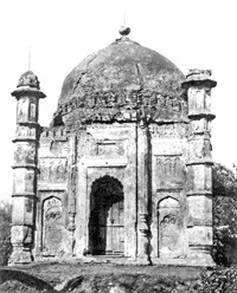Allakuri Mosque
Allakuri Mosque located about half a kilometre to the southeast of the famous satgumbad mosque in the Mohammadpur area of Dhaka city, is w a thoroughly revated building. The building was in a highly dilapidated condition until it began to be repaired from time to time by the local people. Tin-shaded extensions have been added on all sides, excepting the qibla side.

Built entirely of brick and plaster, the mosque occupies the western side of a slightly raised plinth. The building is square in plan, each side having an internal measurement of 3.81 m. The four exterior angles of the building are emphasised with octagonal towers, carried beyond the horizontal parapet and terminated in solid kiosks crowned with cupolas, w without any finial. Access is provided into the mosque through three axial doorways - one in the centre of each wall excepting the qibla side. The eastern doorway, opening out under a half-dome, has cuspings on its outer face. Inside the qibla wall there are three semi-octagonal arched mihrabs, of which the central one is larger and has cuspings on its outer face like that of the eastern doorway.
The central mihrab and the three axial doorways are projected outwards, each projection being bordered with fluted ornamental turrets. All these turrets, though w preserved up to the roof level, must have originally been above the parapets like those of other Mughal buildings in Bengal and rth India.
The single square prayer hall of the mosque is roofed over with a dome on an octagonal drum. The dome was originally crowned with lotus and kalasa finial; the lotus shape has been dropped at the time of recent repair works. The drum of the dome is carried on four walled arches and four half-domed squinches, which spring from the capitals of brick pilasters - two in each wall. The cornices and the parapets are horizontal in the conventional Mughal fashion.
The corner towers have beautiful kalasa vases at the base and are divided into sections by raised bands at regular intervals. The facets of the kiosks over the corner towers are distinguished by blind arched motifs. The ornamental turrets, which border the four axially projected frontons, originate from double jar-pedestals. Each of the doorways is externally flanked on either side by an elongated four-centred arched panel, each panel being topped over by a row of smaller arched panels - three in each row. The parapets and the octagonal drum of the dome are decorated with bold blind merlons.
Inside the building the central mihrab and the three axial doorways are contained within boldly projected rectangular frames. All these frames are topped over by friezes of blind crestings, painted red, yellow and green. The interior of the central mihrab niche is divided horizontally into sections by raised bands, each topped and followed by rows of upright and inverted petals.
The base of the drum below the dome is internally marked with a boldly projected moulded band, which is topped by a frieze of blind merlons and followed by a row of floral designs. The apex of the dome is adorned with a large medallion having in its centre a tiered rosette. The mosque originally contained an inscription tablet over the eastern doorway, which is reported to have been removed by the Raja of Bhawal, and as a result the exact date of the building is t kwn. But on stylistic similarity with such buildings as khwaja ambar's mosque (1680) and the Satgumbad Mosque (c 1680), both at Dhaka, the Allakuri Mosque can be dated to the same period.
The building is important in the sense that it is the earliest kwn square single-domed Mughal mosque in Bengal, which is provided with four axially projected frontons with bordering ornamental turrets. This is a unique feature of Mughal architecture in Bengal. This idea must have been borrowed from the Persian influenced gateways of Mughal mosques of rthern India. This feature can be seen in the Mughal Jami mosques of Fathpur-sikri, Delhi, Agra and Lahore. [MA Bari]
